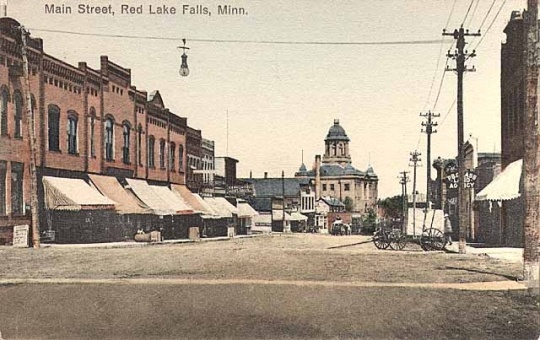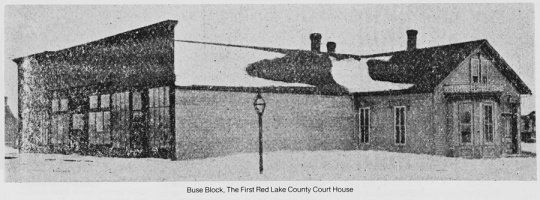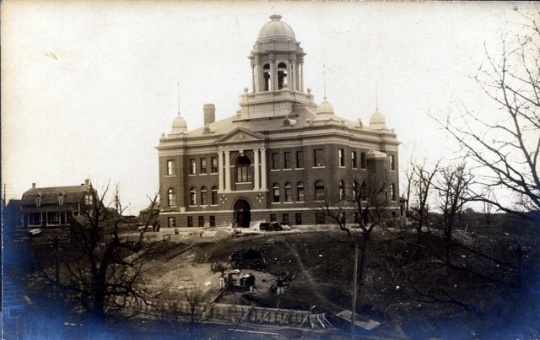An effort to move the Red Lake County seat from Red Lake Falls to Thief River Falls in 1909 divided the citizens of the county. A suspicious courthouse fire on April 23 of that year brought the situation to a head.
In 1904 the US federal government purchased a large piece of reservation land from the Red Lake Band of Chippewa Indians. This nearly doubled the size of what was then Red Lake County, added to the land surrounding Thief River Falls at the north end of the county, and opened the area to homesteading and settler-colonists.
Red Lake Falls, at the southern end of the county, had been acknowledged as the county seat since the county was formed in 1896. After the 1904 expansion, the people of Thief River Falls believed that they would receive enough votes for their city to become the county seat if the matter could be placed on the ballot in a local election.
With this goal in mind, Thief River Falls residents circulated a petition in 1905 to put the county seat question to a county-wide vote. The petition, with more than 2,000 signatures, succeeded only in creating further rancor between the residents of Red Lake Falls and Thief River Falls. This led to two years of legal arguments regarding the validity of the county seat removal petition and, ultimately, its theft from the auditor’s safe.
The county board, by a three to two margin, refused to place the county seat location question on the ballot from 1905 until 1909. By 1909, after losing a series of court cases over five years, Thief River Falls residents realized that success through the election process wasn't likely, so city leaders formed an alternate plan to “secede” and start a new county. They knew that a Minnesota state statute allowed the question of a new county to be placed on the ballot by the governor. This gave Thief River Falls’ ambition to become a county seat a good chance to succeed.
In a last-ditch effort to persuade area farmers to vote for keeping the county together, the city of Red Lake Falls decided to construct a large, rather extravagant courthouse near downtown to replace the older, rented, wood-frame building. It was believed that farmers were likely to behave frugally and would not spend local taxes to build a second courthouse in another city.
The new courthouse was estimated to cost $35,000. The first attempt to finance the building was made when the county board tried to use about $4,000 from the county “road and ditch” fund to excavate the basement for the new building. This failed when the governor ordered the money to be returned to its rightful purpose.
Plan B would have created a bond issue to get the money. This also failed. The county board discovered that it could legally float a bond issue to build a new courthouse under only one of two circumstances: a unanimous vote by the county board to approve the bond issue, or if no courthouse currently existed. With county board members divided over where the county seat should be located, the project reached a stalemate. It took a suspicious fire to resolve the issue.
No one knows for sure what caused the courthouse fire on Friday evening, April 23, 1909. The old wooden building burned to the ground, but all the furniture and records were suspiciously saved. The newspapers of the day gave conflicting accounts. The Red Lake Falls Gazette and Red Lake Falls Courier blamed a crack in the chimney for allowing the flames to get into the walls. The Thief River Falls News and Thief River Falls Press implied suspicions of foul play without using the word “arson.” The St. Hilaire Spectator and the Plummer Pioneer didn’t place any blame.
In 1910 a new courthouse was built with funds from a bond issue. The building was preserved and eventually placed on the National Register of Historic Places in May 1983, but the county itself did not fare so well. In November 1910, voters created Pennington County, its area carved out of part of Red Lake County. Thief River Falls became its county seat.









